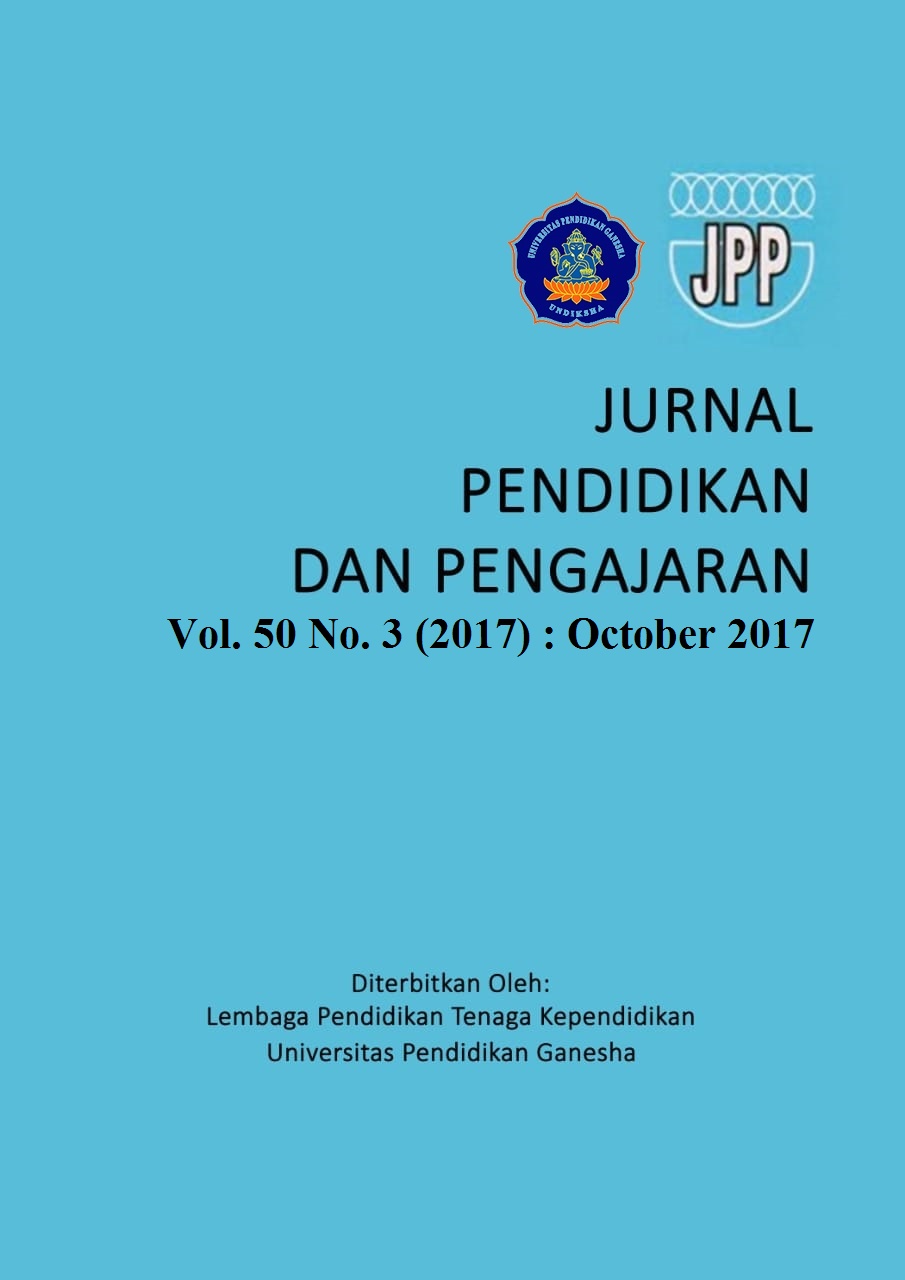IMPROVING STUDENT’S ACTIVITY IN LEARNING CHEMISTRY THROUGH HOMEWORK OF MAKING QUESTIONS
DOI:
https://doi.org/10.23887/jpp.v50i3.12446Keywords:
student’s activity, learning chemistry, homework, making questionsAbstract
This study aims to improve student's activity in learning chemistry at SMAN XI-MIPA1 semester odd SMAN 2 Singaraja in the school year 2015/2016. This study included a type of classroom action research with a research cycle model adopted from the Kemmis & Taggart model. As the subject of this class action research is all students of class XI-MIPA 1 odd semester SMA Negeri 2 Singaraja AcademicYear 2015/2016. The data was collected through observation and student questionnaires. Analyze data using descriptive-qualitative, ie by describing the average number of students who ask at each cycle. The results showed that giving the task of making inquiries at home can increase students' activity in the classroom. This student activity can be seen from the number of students who ask questions in the class. The number of students who asked at the time of observation before the action was about 16.67%. After the action, the number of students who ask in cycle I is 41.67% while in cycle II is 53.13%. Thus the method of providing home duties in the form of making the questionable to increase the activity of learning in the classroom.References
Iriani, Isti Dwi. 2012.Penerapan Metode Pembelajaran Snowball Drilling untuk Meningkatkan Keaktifan Belajar IPS Siswa Kelas VIIIA SMP N I Kalikajar Kabupaten Wonosobo. Skripsi, Universitas Negeri Yogyakarta, (Online). (http://eprints.uny.ac.id/9312/, diakses tanggal 11 Oktober 2015).
Kusumah, Wijaya. 2012. Apakah Metode Pemberian Tugas Rumah Itu?, -(Online). (http://guraru.org/guru-berbagi/apakah_metode_pemberian_tugas_itu/, diakses 11 Oktober 2015).
Mulyasa, H.E. 2011. Praktik Penelitian Tindakan Kelas. Bandung: PT REMAJA ROSDA KARYA.
Rahayu, S & Kita, M. 2011.An Analysis of Indonesia and Japanese Students’ Understandings of Macroscopic and Submicroscopic Levels of Representing Matter and Its Changes.International Journal of Science and Mathematics Education, 32 (8): 667-688.
Rahma, Cahyaningrum. 2012. Pengembangan Media Smart With Chemistry (SwC) Berbasis Web Sebagai Sumber Belajar Mandiri Siswa SMA/MA Kelas XI. Skripsi, Universitas Negeri Yogyakarta, (Online). (http://eprints.uny.ac.id/ 8613/,diakses tanggal 16 November 2015).
Rufiati, Etna. 2011. Apakah karakteristik pembelajaran kimia?, (Online). (http://skp.unair.ac.id/repository/Guru-Indonesia/Apakahkarakteristik _EtnaRufiati_9677.pdf, diakses tanggal 16 November 2015).
Sunarto, Ledy. 2013. Peningkatan Keaktifan Belajar Siswa Melalui Strategi Group Investigation Pada Mapel PKn Materi Perundang-Undangan Siswa Kelas V SD Negeri 01 Gumeng Kecamatan Jenawi Kabupaten Karanganyar Tahun Pelajaran 2012/2013. Skripsi. FKIP Universitas Muhammadiyah Surakarta , (Online). (http://eprints.ums.ac.id/23776/15/NASKAH_ PUBLIKASI.pdf, diakses tanggal 19 November 2015).
Syarifah, Imroatusy. 2010. Pengaruh Pemberian Tugas Pada Mata Pelajaran Aqidah Akhlak Terhadap Prestasi Belajar Aqidah Akhlak Siswa Kelas VII MTs Assalafiyah Luwungragi Bulakamba Brebes.Skripsi. Institut Agama Islam Negeri Walisongo Semarang, (Online). (http://library.walisongo.ac.id/digilib/files/disk1/122/jtptiain-gdl-imroatusys-6082-1-skripsi-p.pdf, diakses tanggal 19 November 2015).
Ulum, Bakhrul. 2013. Keaktifan Belajar Siswa, (Online).
(http://blogeulum.blogspot.co.id/2013/02/keaktifan-belajar-siswa.html, diakses 11 Oktober 2015).
Widyaningsih, Febriani. 2011. Hubungan antara Pemberian Tugas Rumah dengan Hasil Belajar IPS Siswa Kelas 4 SDN Rawasari 03 Pagi Jakarta Pusat. Skripsi. Universitas Muhammadiyah Prof. Dr. Hamka Jakarta, (Online). (https://auroralubna.files.wordpress.com/2012/02/wiwit.pdf, diakses tanggal 11 Oktober 2015).
Downloads
Published
How to Cite
Issue
Section
License
Authors who publish with Jurnal Pendidikan dan Pengajaran agree to the following terms:- Authors retain copyright and grant the journal the right of first publication with the work simultaneously licensed under a Creative Commons Attribution License (CC BY-SA 4.0) that allows others to share the work with an acknowledgment of the work's authorship and initial publication in this journal
- Authors are able to enter into separate, additional contractual arrangements for the non-exclusive distribution of the journal's published version of the work (e.g., post it to an institutional repository or publish it in a book), with an acknowledgment of its initial publication in this journal.
- Authors are permitted and encouraged to post their work online (e.g., in institutional repositories or on their website) prior to and during the submission process, as it can lead to productive exchanges, as well as earlier and greater citation of published work. (See The Effect of Open Access)





